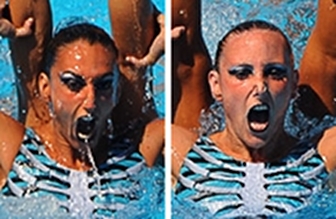Widow's peak: The myth
Some people have a prominent V-shaped point at the front of their hairline, called a widow's peak, while other people have a hairline that goes straight across. Widow's peak is sometimes used to illustrate basic genetics; the myth is that it is controlled by one gene with two alleles, and the allele for widow's peak is dominant over the allele for straight hairline. There is no evidence that this myth is true. I do not know how the myth got started; I have searched the literature thoroughly, and I have not found any scientific papers that make this claim.
The reality
Widow's peak as a character
I found only two papers that have looked at widow's peak in the general population. Smith and Cohen (1973) looked at photographs of male medical students and concluded that 32 out of 1039 (3%) had a "slight but noticeable" widow's peak and one had a "more distinctive and obvious" widow's peak. Nusbaum and Fuentefria (2009) looked at 360 women in hair salons and concluded that 81% of them had a widow's peak.
Unfortunately, neither of these sets of authors defined what they counted as a widow's peak. To find a picture of people with and without a widow's peak, I searched for images of synchronized swimmers (because they wear their hair pulled back, and because they look goofy). I had to look at a lot of pictures before I found the clear widow's peak in the picture above, so I think that Nusbaum and Fuentefria (2009) must have used a very loose definition of widow's peak if they counted 81% of women as having one. Unless there is a very large difference between males and females, Smith and Cohen (1973) must have used a much stricter definition in their study.
In addition to ambiguities about who does or does not have a widow's peak, there is the problem of age. The hairline of many men recedes over time, and it often recedes more slowly in the middle. It could therefore be difficult to distinguish between a receding hairline and a true widow's peak in adult men.
Family and twin studies
There are several papers on people with rare genetic disorders who are more likely to have a widow's peak; see the OMIM entry. However, I do not know of any family or twin studies of widow's peak in the general population. Unless I've failed to find some old paper, there is no published evidence that widow's peak has a genetic basis.
Conclusion
It is hard to draw a firm line between widow's peak and straight hairline, and there is no published evidence about whether it is influenced by genetics. You should not use widow's peak to demonstrate simple genetics.
References
Nusbaum, B.P., and S. Fuentefria. 2009. Naturally occurring female hairline patterns. Dermatologic Surgery 35: 907-913.
Smith, D.W., and M.M. Cohen. 1973. Widow's peak scalp-hair anomaly and its relation to ocular hypertelorism. Lancet 2: 1127-1128
Return to John McDonald's home page
This page was last revised December 8, 2011. Its address is http://udel.edu/~mcdonald/mythwidowspeak.html. It may be cited as pp. 67-68 in: McDonald, J.H. 2011. Myths of Human Genetics. Sparky House Publishing, Baltimore, Maryland.
©2011 by John H. McDonald. You can probably do what you want with this content; see the permissions page for details.

